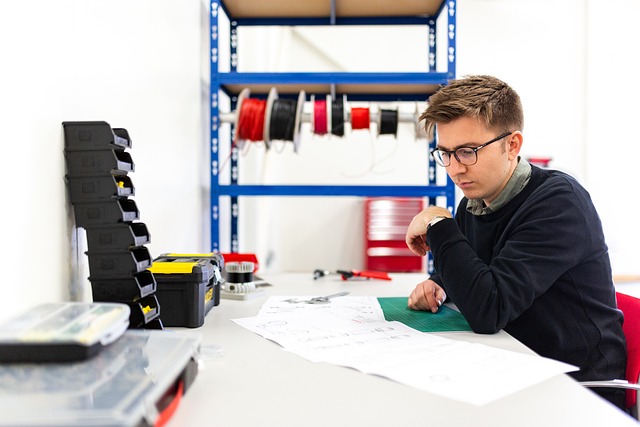3D structural visualization is a revolutionary tool for steel truss design, transforming complex blueprints into interactive models that enhance precision and efficiency. This technology enables early identification of flaws and interference issues, promotes collaborative validation among stakeholders, and facilitates dynamic exploration of different configurations, materials, and loading scenarios. By streamlining workflows, minimizing errors, improving cost predictions, and showcasing aesthetic appeal, 3D visualization is indispensable for complex geometric designs, ensuring structural integrity, efficient project timelines, and architecturally stunning builds. Advanced software requires a blend of engineering expertise and artistic skill to produce detailed blueprints that guide fabrication while maintaining stability and load-bearing capacity.
In today’s architectural landscape, precise detailing is paramount, especially for complex structures like steel trusses. This article explores the pivotal role of 3D structural visualization in the design and rendering of these intricate systems. We delve into how advanced tools enhance precision, allowing architects and engineers to represent challenging geometries accurately. From creating realistic renderings to showcasing connection details, we uncover techniques, software, and real-world applications that drive innovation in steel truss design, setting the stage for future trends in 3D structural visualization.
The Role of 3D Structural Visualization in Steel Truss Design
In the realm of steel truss design, 3D structural visualization plays a pivotal role in achieving precision detailing. This advanced technology allows engineers and architects to transform complex geometric structures into tangible, three-dimensional models, facilitating better comprehension and analysis. By rendering intricate trusses in 3D, professionals can spot potential design flaws or interference issues early in the development stage, streamlining the overall construction process.
Moreover, 3D visualization tools enable dynamic exploration of various truss configurations, materials, and loading scenarios. This interactive aspect enhances collaboration among project stakeholders, as everyone involved—from structural engineers to designers—can inspect and validate the structural integrity of the trusses. As a result, 3D structural visualization is not just a tool for visualization but a game-changer in ensuring the accuracy and safety of steel truss designs.
– Importance and benefits of 3D visualization tools
In today’s digital era, 3D structural visualization has become an indispensable tool for architects and engineers working with steel truss and connection renderings. It allows for precise detailing and accurate representation of complex structural designs, enabling better communication and understanding among project stakeholders. With 3D visualization, folks can virtually explore every angle and dimension of the structure before it’s even built, fostering a more collaborative environment and streamlining the design process.
This advanced technology offers numerous benefits, including enhanced accuracy, efficient modifications, and improved cost estimation. By visualizing structures in three dimensions, professionals can quickly identify potential issues, such as interference or misalignments, and make necessary adjustments to avoid costly on-site changes. Moreover, 3D structural visualization enables clients and investors to appreciate the intricate beauty of steel truss designs, revolutionizing how we perceive and understand these architectural marvels.
– How it aids in precision detailing and complex geometry representation
Steel truss and connection renderings play a pivotal role in enhancing precision detailing, especially within complex geometric structures. By employing advanced 3D structural visualization techniques, engineers and designers can accurately represent intricate truss systems, showcasing their interplay of forces and aesthetics. This level of detail is paramount for conceptualization and communication during the design phase, allowing stakeholders to grasp the structural integrity and visual appeal of the intended build.
The process facilitates a deeper understanding of the relationships between various components, ensuring seamless integration and minimal errors in construction. Moreover, it enables quick identification and resolution of potential issues, streamlining the project timeline and budget. With intricate geometry brought to life through rendering, teams can make informed decisions, ultimately leading to the realization of architecturally stunning and structurally sound structures.
Creating Accurate Steel Truss Renderings
Creating accurate steel truss renderings involves a meticulous process that combines engineering precision with artistic vision. Professionals utilize advanced 3D structural visualization software to model every intricate detail of the truss, from the curvature of individual members to the precise angles of connections. This digital craftsmanship ensures that every aspect of the steel structure is represented with unwavering accuracy, allowing for thorough analysis and validation before physical construction begins.
The process demands a deep understanding of both structural integrity and aesthetic appeal. By carefully mapping out each node and joint, designers can produce renderings that not only look striking but also serve as reliable blueprints for fabrication. This level of detail is crucial in steel truss projects, where the slightest deviation can impact overall stability and load-bearing capacity.
In conclusion, leveraging 3D structural visualization for steel truss design offers immense advantages, especially when tackling intricate geometries. These advanced tools not only enhance precision detailing but also streamline the planning and communication process. By enabling professionals to create accurate renderings, 3D visualization techniques ensure that complex steel truss structures are designed with confidence and efficiency, setting a new standard in construction accuracy.
